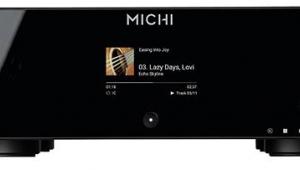Fisher AD 800 (Vintage)

In the early 1970s Sanyo was a UK market leader in the field of music centres that were extremely popular here, but its separate hi-fi units were not as successful. It was intended that the acquisition of the Fisher brand (in 1975) would solve this problem and less than a year after the CD format had first been made commercially available by Philips and Sony, it launched its first machine, offered in the UK as the Fisher AD 800.
A vertical front loader, the AD 800 was a confident entry into the digital field. One reason Sanyo was able to bring this model to market so rapidly was its use of integrated circuits made by Sony. This set the basic architecture of the Fisher AD 800 as a 16-bit design with no oversampling or digital filter.
A single Sony CX20017 16-bit DAC was shared between the two channels with the left and right signals being separated later in the analogue domain – a familiar Japanese practice. This approach, and the absence of oversampling, meant that high-order filter blocks were required to attenuate any signals above the audible range.
Though Sanyo relied heavily on Sony technology for the AD 800, the servo circuit and optical deck were constructed by Sanyo, as were the bulk of the passive components and many of the non-Sony ICs.
The mechanism was simply constructed, being composed mainly from steel pressings. A brush-type DC motor was used to spin the disc. Whereas many manufacturers chose to make their first CD models ‘statement pieces’, the basic painted mouldings of the AD 800’s cabinet are disarmingly modest, and the quality of construction isn’t outwardly better than that of a budget cassette deck of the period.
The front panel is dominated by a bottom-hinged CD loader into which the disc is dropped, initiating the loading process automatically. On the right-hand side there’s a large membrane-type keypad and displays for the track time, track number and index or the sequence for programmed track replay.
The programming mode is rather confusing, but functions rapidly once you get the hang of it, although the AD 800 takes a while to cue up a song. The usual keys are provided for skipping tracks and moving forwards or back during a particular selection, but it is possible to go beyond the recorded content of the disc and then have to completely re-start the playback process to get the sound back!
Sounds like a Sony
We were pleased to find that not only was the background subjectively silent, but the mechanism made no audible noises that you would notice from the listening position. Given the sheer amount of Sony hardware inside, it’s perhaps no surprise that the AD 800 sounds very similar to a CDP-101. In short, this means that the bass is full but a bit metallic while there is an amount of phase-related confusion in the treble. A bright midrange is another feature. The result of this is that vocals enjoy a real presence lift, making song lyrics very easy to follow, while instruments such as brass and woodwind gain an extra bit of early multi-bit CD ‘polish’.
We tried a selection of CDs broadly contemporaneous with the machine, including Alison Moyet’s first solo album Alf [CBS]. The abrupt percussion that runs through all the tracks was pushed firmly centre stage by a bright and sparkling presentation. Moyet’s vocals, although explicit, were tainted by a slightly gritty quality, but a tight, brisk bass was a positive feature of the AD 800. There was no smear or one-note boom – everything down at the bottom end sounded precise.
With Svendsen’s Romance in G [DG] the richness of the woodwind and the delicacy of the strings were communicated particularly well, with only a slight trace of steely harshness around the high notes. The space around the instruments was noteworthy too.
Verdict
The Fisher AD 800 looks almost too small and playfully styled to be a first-generation CD machine. The Sony-based electronics provide a distinctly ‘Japanese’ sound, instantly evocative of the early CD era, making this model a particularly interesting purchase for any keen vintage collector.
Originally published in the 2013 Yearbook
























































